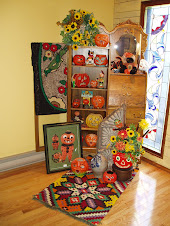


Much of the lore associated with the egg and the Easter bunny may be traced to Germany, where pagan tribes regarded the egg as the symbol of life's beginning, and its yolk and white as the sun and moon. It was the rabbit who served escort to the Teutonic goddess Ostara, whose name in an altered form became that of the festival, Easter.
The bulk of Easter collectibles relate in some way to either eggs or rabbits, however, other animal forms such as lambs, chickens, and ducks are found, and there are more toys than are associated with any other holiday except Christmas.
Hens and chickens run a distant second to the rabbit as Easter symbols.
The custom of decorating eggshells originated in eastern Europe. Blown eggs were embellished with bead work and decoupage, proving to be very fragile. Spun sugar eggs have been produced in Europe since the turn of the century. These often are made with an interior view of a lithographed, die-cut scene, or small three dimensional figures.
Greeting cards both penny postal type and envelope enclosed forms have been produced by English, American, and German printing houses since before 1900.

No comments:
Post a Comment